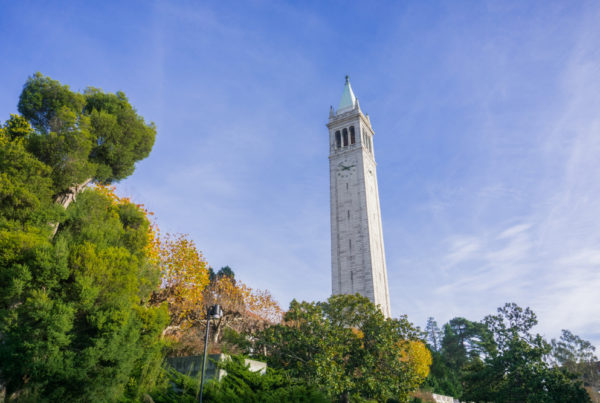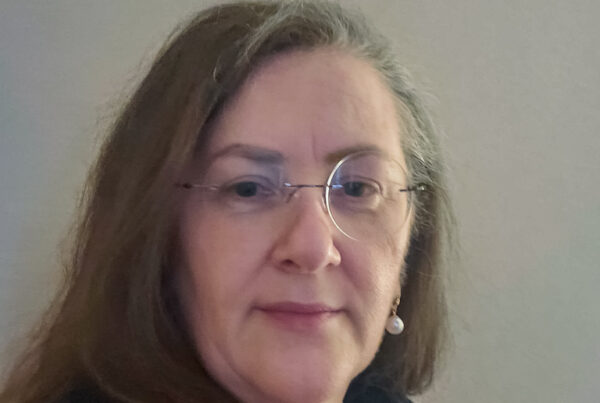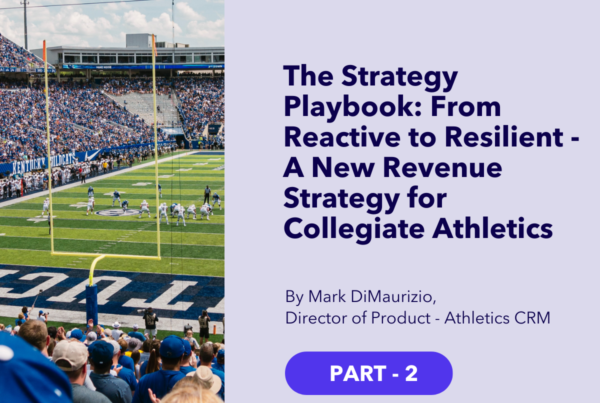Recently, I had the opportunity to speak with Cindy Casper, the Managing Director of Constituent Knowledge and Insights at the Enterprise Marketing Hub at Arizona State University.

I first heard of the Enterprise Marketing Hub and their work at CASE’s virtual DRIVE/Cast conference in May 2020 in ASU’s session “Driving Alumni and Donor Affinity Using Big Data.” I was intrigued by how the Enterprise Marketing Hub is measuring alumni affinity and quantifying its relationship to alumni giving, so I spoke with Cindy to learn more about their innovative work.
Here’s a preview of what you’ll learn:
- How marketing and intentional brand building can help institutions bridge the gap between perception and reality in engagement, programming, and outreach
- How looking at prospects, donors, and alumni as customers can better help advancement departments identify and meet their needs
- How using data insights can enable departments across campus to better collaborate
- Specific ideas for how you can start to use these insights at your own institution
What exactly is the Enterprise Marketing Hub?
Cindy explained that the Enterprise Marketing Hub (the Hub) was started seven years ago by Dan Dillon, who was a chief marketing office for restaurants and in the consumer packaged goods realm. He worked on brand management for several major food brands, including the launch of Coke Zero. ASU committed to the Hub as a way to have a single point of visibility into media buying, performance, and insights driving ASU’s collective marketing efforts to students, donors, and other stakeholders.
Cindy elaborated, “In business, you don’t make decisions without insights; it’s become a bit of a science. Marketing is measurable so you can report back ROI. That way you can position the brand and drive volume, which are not discrete activities. In my previous work, I did TV advertising testing, which led to more general marketing research. I then worked on the supplier side for Procter & Gamble.
In fact, P&G invented marketing research. They used to have women employees go door-to-door to ask other women about which cleaning products they were using and how they liked P&G products. Then, these women employees would go back to their cars and try to write down all they’d learned about how people used these products, what they were looking for, etc. One-hundred years later, marketing research is huge. I think insights should not be limited to marketing research, but include other ways of understanding people that come from different disciplines or fields, like big data or AI.”
How do marketing and brand insights apply to higher education?
Cindy pointed out that higher education is one of the last industries to embrace marketing. She speculated, “Maybe because marketing feels too desperate or because it changes the power structure institutions have with their customers? But a brand helps the customer understand what to expect from the product, service, or experience. And colleges and universities still have to communicate what they’re about, what they do, and how they do it. It’s not that marketing and branding don’t exist in higher education, but, for some reason, not-for-profit higher education isn’t embracing or talking about it.” She explained that she’s interested in moving away from how universities compete with each other to sharing data and methods.
In higher education, how can we help find truths that will impact marketing and its effects? “This is a cycle—you learn, predict, execute, get feedback, and then start over,” she said. “We’re constantly trying to evolve.”
“The Hub tries to create greater consistency in how the ASU brand is represented. Four years ago, we started the Core Brand Group (CBG), made up of staff in the office of president, media relations, athletics, student services, foundation, etc. There is no way to centralize marketing across the whole university system; over one thousand people have marketing in their title and most of them don’t report to us. Instead, the CBG is more of an influence model for those who want to take part—we have all hands meetings, summer camp, and offer training.”
What is happening in marketing at ASU?
Cindy pointed out a challenge related to perception and awareness. As an institution, ASU is innovative. But constituents may not always be aware of all the innovative programs and initiatives on-campus. The institution wants to raise awareness of what they’re doing so those activities and programs can have a greater impact.
Cindy said, “Now, we’re working actively to be seen as the ‘New American University.’ We’re impacting higher education globally and promoting access. But we can’t solve this by ourselves—we’re involved with a lot of schools around the world. We need other schools to step up their game. In marketing, one of the goals is to treat people the way they want to be treated, especially in a way that sets you apart and that you can deliver upon. Brands choose to stand for something and a particular group of people, so you have to ensure that brand promise is fulfilled.”
What kind of research are you doing? What are the insights?
As one example, Cindy explained how the Hub is gaining new insights by a) talking to high schoolers about what they’re looking for in their college experience and b) talking to alumni to see what experience ASU is actually delivering, to see how it compares.
Considering how COVID-19 is changing the nature of higher education, we at ALUMinate think gathering these kinds of insights will be extremely important.
In the context of higher education, what is a brand and why does it matter?
When it comes to their brand, Cindy explained that a university needs to balance and be aware of the perception versus the reality. As in, is what an institution claims to offer actually what they’re offering? Or, are their branding and marketing efforts doing a good job of representing the reality of all that they can offer and do for students and alumni?
To help align perception and reality at ASU, the Alumni Engagement and Impact Office is connected to the Hub. One way the Impact Office and the Hub are working to ensure that the reality measures up to the perception is through the Sun Devil Rewards app. The point of the app is to give to alumni without asking for anything in return. As Cindy said, ASU realized they needed to change that ratio.
The app includes all the content that alumni and other users (one third of the users are students, one third are alum, and the rest are fans, faculty, and staff) find valuable, such as news from the university, events in the user’s area, games, and trivia. In addition, the app has incentives for users to engage with ASU beyond just consuming the content. Users earn “pitchforks” (tokens in the app), which they can redeem for stuff. The stuff they can redeem ranges from a unique ASU experience (such as getting to meet the football team during halftime or meeting with an ASU scientist in their lab), to a chance to win a valuable trip abroad, or receiving a smaller item like an ASU coffee mug. The Hub gets data back on how people use the app, which allows the Hub staff to run analytics to try to improve the app experience.
ASU has also designed a broader university app for students, which was introduced about a year ago. As Cindy describes it, “This app is the students’ lifeline to the campus; it shows the weather, their schedule, their to-do list—it’s basically the student portal to the university.”
How else does the Hub’s work relate to alumni and donor engagement?
Cindy says she thinks universities and alumni have outgrown the old alumni association model. “Alumni don’t need their chapter network to be able to find people. Nontraditional students are now the majority; they might not want that traditional athletic or Greek experience. But the percentage of those who want to be connected to the knowledge and research of the school is going up (we call these Lifelong Learners in our affinity modeling), also, those who want to make the world a better place (Self Actualizers) is going up.
Through our affinity modeling and research, we’re trying to help people find ways to connect instead of having to convene in-person. We want to give alumni more ways to learn and impact the greater good virtually, without it being something like a traditional phone campaign. We want it to be more around their passions or interests. We’re working on models to learn who is interested in what, so we can offer tailored help. And when we offer help, we’re not asking or expecting them to do something for the school in return. At some point some of these people may be primed to want to give back, but this will be earned and not expected. The message we’re sending is, ‘we’ll give you a great education and demonstrate that; when you graduate that is sort of the end of what we agreed to, you shouldn’t feel an obligation to pay beyond what you’ve already paid.’”
Unless, of course, they want to. As we’ve written about before, real philanthropists want to give back, you shouldn’t have to twist anyone’s arm to give.
But this isn’t just about major gifts for ASU. As Cindy explained, “We want to inspire more people to want to give at any level.”
“A brand is about understanding an unmet need of the customer [in this case, the student or alumni] and solving that need. It is not about what we want. The customer doesn’t typically care if we [the business or institution] needs more revenue; they want to know, ‘What are you doing for me that I’d be willing to give you more money for?’ At ASU, we start from the perspective that we should care about them, not they should care about what the school’s doing. This is where good research comes in—it is a way for people to tell you about their pain and the gaps [between perception and reality].”
“In higher education, there are no shortage of issues—you can find many unmet needs. For example, career services might be offered at a school but there may be low awareness among alumni of what is offered, that it’s free, or how they access those services. That is a perception gap that could be addressed through insights and intentional branding. Marketing can work in the middle. We’re trying to get school staff to move from thinking about what they want or how they can get their goals met to instead thinking about if they can solve a problem for their customers/prospective donors/former students. If you can [solve that problem], some of those constituents will even be willing to pay you for it or speak highly of you. They might be more likely to send their own child to the school or engage in ways that generate revenue. You can help drive affinity and be a more relevant part of their life.”
As far as advancement, the Foundation does not fall under the Hub at ASU, but the Foundation, the Alumni Engagement and Impact Office, and the Hub all have a joint strategy to increase alumni affinity. Together they try to figure out: what is the right cadence to engage alumni? What are the ways they want to be engaged?
Can you talk a bit more about data and analytics in this work?
Regarding alumni giving, Cindy said that many schools focus on a prospect’s capacity to give instead of their interest or affinity. “So many schools haven’t formalized when ‘the ask’ occurs. It is hard when managing a big dataset to know who to ask and when; that attitude isn’t in the dataset. But it is now for ASU. It took us about six months to get all the data and get it integrated (we had to do name and address matching). Now, that alumni affinity score lives in the same system that the Foundation is using for their outreach. The Foundation staff knows what it is and that it is there, but they’re still not sure how to use it, which is what we’re addressing now. It was recently announced that the research and analytics teams will report to me.”
“Our [Foundation] team works hard to serve the top of the donor pyramid, but they’re also honing their process for how to move people from the bottom of the pyramid up. Having really in-depth data works when calling on individuals but not when doing mass marketing. In this case, you have to use that data to understand segments of people. You don’t need that same level of depth but you need the breadth to create communications that will be relevant for segments of people. This will help you get your foot in the door, but you don’t want to start with asking for money. Instead, you start by understanding what their needs are and if there is potential to cultivate a relationship. Initially, this has to happen in an almost impersonal, batch kind of way. For example, people in segment X want something like Y, so you use data to communicate to them that it is available (as a first step).”
“Positive experiences increase affinity. Drivers of affinity are useful to use. We want to increase it. We want to know, what are the levers (for example, helping alumni advance their careers) that would make them love us more.”
Contact us to learn how Affinaquest’s data enrichment and predictive analytics solutions can help you develop an accurate understanding of a potential donor before the first conversation even happens.
What can other schools do to get started on this?
Cindy’s advice on this: “If an institution can’t afford to study their own alumni population, they could use the ASU national study and the segments from that data as a proxy. Let’s say that “Prepares Me” is a school’s biggest factor, then they can look at activities or programs that help alumni be better prepared for their lives and careers, but that alumni might not be aware of. For example, a school could assess their career services—do their alumni know what is available? Think like a mass marketer—instead of focusing on turnout numbers to those career services programs and events, consider what percentages of alumni are taking advantage of them and how you can increase those percentages. There are a lot of ways to learn from alumni: talking with them one-on-one, doing quantitative research, looking at behavioral data, etc.”
“We’ve found that the one variable that makes the biggest difference [for students] is if they had a mentor who encourages them to pursue their goals and dreams. This correlates with higher affinity, retention, and better mental health findings. And the mentor doesn’t even have to be a university-affiliated person. This probably isn’t in most university databases, but if there is a way for a university to know that every student feels like they have that kind of mentor figure, that would be very useful. At ASU, we actually have higher affinity among our online students, possibly because every online student gets assigned not only an academic advisor but a success coach.”
Another tip: “Even if a school can’t afford to do formal research, they could at least be talking to alumni, and not just the usual ones who love the school, those high affinity alums. You need to find the random alum who didn’t approach you. It is even more important now that we listen since we’re so physically distanced. Now, more than ever, we need to listen to all different constituents who probably have new fears and concerns.”
I hope you found this conversation helpful! As always, I welcome your thoughts and comments on this article.
Finally, I want to thank Cindy Casper for taking the time to speak with me.




